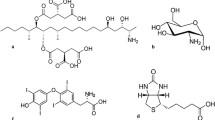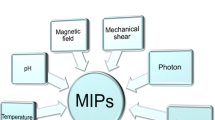Abstract
Molecular imprint sorbent assays (MIAs) have been applied to an increasing number of analytes of medical and environmental interest: the sensitivities and selectivities of these assays are comparable to immunoassays employing biological antibodies. In a number of cases complete analytical procedures starting from raw samples (blood, plasma and urine) have been demonstrated. There have been significant advances in applying MIPs in new formats and in the use of non-radioisotope labels. Progress in the field is reviewed, with particular emphasis on the technical aspects and new innovations. It is demonstrated that many of the perceived drawbacks of molecular imprinted polymers (MIPs) do not hinder their application in competitive binding assays: Many MIAs have been applied in aqueous systems and a heterogenous distribution of binding sites is not problematic, provided the recognition sites which bind the probe most strongly are selective.
Similar content being viewed by others
References
Andersson LI (2000) J. Chromatogr. B. 739: 163-173.
Andersson LI (2001) Application of molecularly imprinted polymers in competitive ligand binding assays for analysis of biological samples. In: Molecularly Imprinted Polymers: Manmade Mimics of Antibodies and their Applications in Analytical Chemistry, (pp. 341-354). Sellergren B (ed). Elsevier: Amsterdam.
Andersson LI et al. (1995) Proc. Nat. Acad. Sci. USA. 92: 4788-4792.
Andersson LI (1996) Anal. Chem. 68: 111-117.
Ansell RJ & Mosbach K (1998) Analyst 123: 1611-1616.
Ansell RJ, Ramstrom O & Mosbach K (1996) Clin. Chem. 42: 1506-1512.
Bengtsson H, Roos U & Andersson LI (1997) Anal. Cmmun. 34: 233-235.
Berglund J et al. (1996) Bioorg. Med. Chem. Lett. 6: 2237-2242.
Biffis A et al. (2001) Macr. Chem. Phys. 202: 163-171.
Bock JL (2000) Am. J. Clin. Pathol. 113: 628-646.
Catt K, Niall HD & Tregear GW (1967) Nature 213: 825-827.
Hage DS (1999) Anal. Chem. 71: 294R-304R.
Haupt K, Dzgoev A & Mosbach K (1998) Anal. Chem. 70: 628-631.
Haupt K, Mayes AG & Mosbach K (1998) Anal. Chem. 70: 3936-3939.
Haupt K (1999) React. Funct. Polym. 41: 125-131.
Iqbal SS et al. (2000) Mater. Sci. Eng. C, 7: 77-81.
Kroeger S et al. (1999) Anal. Chem. 71: 3698-3702.
Levi R et al. (1997) Anal. Chem. 69: 2017-2021.
Mayes AG & Lowe CR (1998) Optimization of molecularly imprinted polymers for radio-ligand binding assays. In: Methodological Surveys in Bioanalysis of Drugs, vol. 25. Drug Development Assay Approaches Including Molecular Imprinting and Biomarkers, (pp. 28-36). Reid ED, Hill HM & Wilson ID (eds.) Royal Society of Chemistry.
Mayes AG & Mosbach K (1996) Anal. Chem. 68: 3769-3774.
Mayes AG, Andersson LI & Mosbach K (1994) Anal. Biochem. 222: 483-488.
Muldoon MT & Stanker LH (1995) J. Agric. Food Chem. 43: 1424-1427.
Piletsky SA et al. (1997) Anal. Lett. 30: 445-455.
Piletsky SA et al. (2000) Anal. Chem. 72: 4381-4385.
Price CP & Newman DJ (1997) Principles and Practice of Immunoassay. 2 edn. Macmillan Reference Ltd., London.
Ramstrom O, Ye L & Mosbach K (1996) Chem. Biol. 3: 471-477.
Schollhorn B et al. (2000) Analyst 125: 665-667.
Sellergren B & Andersson LI (2000) Methods (Companion to Methods in Enzymology) 22: 92-106.
Senholdt M et al. (1997) Anal. Lett. 30: 1809-1821.
Siemann M, Andersson LI & Mosbach K (1996) J. Agric. Food Chem. 44: 141-145.
Surugiu I et al. (1999) Analyst 125: 13-16.
Surugiu I et al. (2001) Anal. Chem. 73: 487-491.
Takeuchi T, Dobashi A & Kimura K (2000) Anal. Chem. 72: 2418-2422.
Umpleby RJI, Bode M & Shimizu KD (2000) Analyst 125: 1261-1265. ]
Vlatakis G et al. (1993) Nature 361: 645-647.
Ye L, Cormack PAG & Mosbach K (1999) Anal. Commun. 36: 35-38.
Ye L, Weiss R & Mosbach K (2000) Macromolecules 33: 8239-8245.
Ye L & Mosbach K (2001) J. Am. Chem. Soc. 123: 2901-2902.
Yilmaz E, Mosbach K & Haupt K (1999) Anal. Commun. 36: 167-170.
Yilmaz E, Haupt K & Mosbach K (2000) Angew. Chem. Int. Ed. Eng. 39: 2115-2118.
Author information
Authors and Affiliations
Rights and permissions
About this article
Cite this article
Ansell, R.J. MIP-ligand binding assays (pseudo-immunoassays). Bioseparation 10, 365–377 (2001). https://doi.org/10.1023/A:1021502122227
Issue Date:
DOI: https://doi.org/10.1023/A:1021502122227




